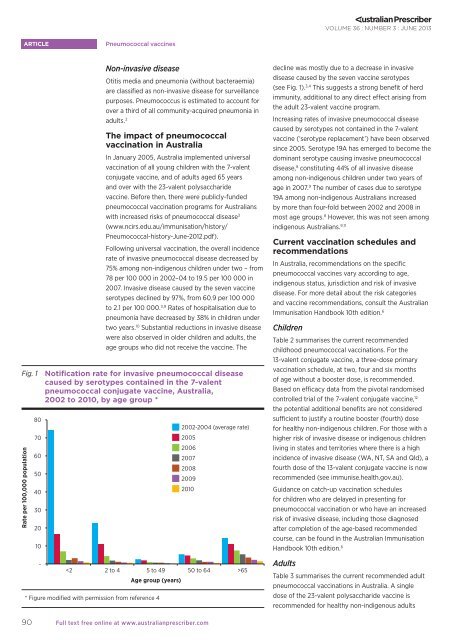download the full PDF issue - Australian Prescriber
download the full PDF issue - Australian Prescriber
download the full PDF issue - Australian Prescriber
You also want an ePaper? Increase the reach of your titles
YUMPU automatically turns print PDFs into web optimized ePapers that Google loves.
VOLUME 36 : NUMBER 3 : JUNE 2013<br />
ARTICLE<br />
Pneumococcal vaccines<br />
Non-invasive disease<br />
Otitis media and pneumonia (without bacteraemia)<br />
are classified as non-invasive disease for surveillance<br />
purposes. Pneumococcus is estimated to account for<br />
over a third of all community-acquired pneumonia in<br />
adults. 2<br />
The impact of pneumococcal<br />
vaccination in Australia<br />
In January 2005, Australia implemented universal<br />
vaccination of all young children with <strong>the</strong> 7-valent<br />
conjugate vaccine, and of adults aged 65 years<br />
and over with <strong>the</strong> 23-valent polysaccharide<br />
vaccine. Before <strong>the</strong>n, <strong>the</strong>re were publicly-funded<br />
pneumococcal vaccination programs for <strong>Australian</strong>s<br />
with increased risks of pneumococcal disease 3<br />
(www.ncirs.edu.au/immunisation/history/<br />
Pneumococcal-history-June-2012.pdf).<br />
Following universal vaccination, <strong>the</strong> overall incidence<br />
rate of invasive pneumococcal disease decreased by<br />
75% among non-indigenous children under two – from<br />
78 per 100 000 in 2002–04 to 19.5 per 100 000 in<br />
2007. Invasive disease caused by <strong>the</strong> seven vaccine<br />
serotypes declined by 97%, from 60.9 per 100 000<br />
to 2.1 per 100 000. 3,9 Rates of hospitalisation due to<br />
pneumonia have decreased by 38% in children under<br />
two years. 10 Substantial reductions in invasive disease<br />
were also observed in older children and adults, <strong>the</strong><br />
age groups who did not receive <strong>the</strong> vaccine. The<br />
Fig. 1 Notification rate for invasive pneumococcal disease<br />
caused by serotypes contained in <strong>the</strong> 7-valent<br />
pneumococcal conjugate vaccine, Australia,<br />
2002 to 2010, by age group *<br />
Rate per 100,000 population<br />
80<br />
70<br />
60<br />
50<br />
40<br />
30<br />
20<br />
10<br />
-<br />
Age group (years)<br />
* Figure modified with permission from reference 4<br />
2002-2004 (average rate)<br />
2005<br />
2006<br />
2007<br />
2008<br />
2009<br />
2010<br />
65<br />
decline was mostly due to a decrease in invasive<br />
disease caused by <strong>the</strong> seven vaccine serotypes<br />
(see Fig. 1). 3,4 This suggests a strong benefit of herd<br />
immunity, additional to any direct effect arising from<br />
<strong>the</strong> adult 23-valent vaccine program.<br />
Increasing rates of invasive pneumococcal disease<br />
caused by serotypes not contained in <strong>the</strong> 7-valent<br />
vaccine (‘serotype replacement’) have been observed<br />
since 2005. Serotype 19A has emerged to become <strong>the</strong><br />
dominant serotype causing invasive pneumococcal<br />
disease, 8 constituting 44% of all invasive disease<br />
among non-indigenous children under two years of<br />
age in 2007. 9 The number of cases due to serotype<br />
19A among non-indigenous <strong>Australian</strong>s increased<br />
by more than four-fold between 2002 and 2008 in<br />
most age groups. 8 However, this was not seen among<br />
indigenous <strong>Australian</strong>s. 9,11<br />
Current vaccination schedules and<br />
recommendations<br />
In Australia, recommendations on <strong>the</strong> specific<br />
pneumococcal vaccines vary according to age,<br />
indigenous status, jurisdiction and risk of invasive<br />
disease. For more detail about <strong>the</strong> risk categories<br />
and vaccine recommendations, consult <strong>the</strong> <strong>Australian</strong><br />
Immunisation Handbook 10th edition. 6<br />
Children<br />
Table 2 summarises <strong>the</strong> current recommended<br />
childhood pneumococcal vaccinations. For <strong>the</strong><br />
13-valent conjugate vaccine, a three-dose primary<br />
vaccination schedule, at two, four and six months<br />
of age without a booster dose, is recommended.<br />
Based on efficacy data from <strong>the</strong> pivotal randomised<br />
controlled trial of <strong>the</strong> 7-valent conjugate vaccine, 12<br />
<strong>the</strong> potential additional benefits are not considered<br />
sufficient to justify a routine booster (fourth) dose<br />
for healthy non-indigenous children. For those with a<br />
higher risk of invasive disease or indigenous children<br />
living in states and territories where <strong>the</strong>re is a high<br />
incidence of invasive disease (WA, NT, SA and Qld), a<br />
fourth dose of <strong>the</strong> 13-valent conjugate vaccine is now<br />
recommended (see immunise.health.gov.au).<br />
Guidance on catch-up vaccination schedules<br />
for children who are delayed in presenting for<br />
pneumococcal vaccination or who have an increased<br />
risk of invasive disease, including those diagnosed<br />
after completion of <strong>the</strong> age-based recommended<br />
course, can be found in <strong>the</strong> <strong>Australian</strong> Immunisation<br />
Handbook 10th edition. 6<br />
Adults<br />
Table 3 summarises <strong>the</strong> current recommended adult<br />
pneumococcal vaccinations in Australia. A single<br />
dose of <strong>the</strong> 23-valent polysaccharide vaccine is<br />
recommended for healthy non-indigenous adults<br />
90<br />
Full text free online at www.australianprescriber.com
















